Small Collects is what I once wrote on a box of stuff that had either been sent to me over the years or I'd found or bought on travels. This is a subset of infrequent posts that feature my personal collection of ephemera and creative publishing outputs.
PS There is another book, called Artists Who Make Books, in the universe, and it annoys me intensely, because (a) many of the artists listed get other people to make their books and (b) it's a cockforest, with only about 4 women in the entire book, and two of those are the essayists.
I'm so excited. A desultory search on AbeBooks for something (I can't even remember what) a few weeks ago, dredged up a catalogue that I may, I thought, or may not have packed in a box somewhere, but it's cheap enough that I should buy it and if it is a double, I can pass it on.
Well. It arrived at my door in the brave-new-world way: a doorbell ring, the parcel dumped on the doorstep and the postie buggering off as fast as possible to avoid contact. A slim but quite large envelope, containing this beauty:
I have seen it before, in my art school's library, but I haven't looked at it since I was a student falling in love with artist books. It's a catalogue for a travelling exhibition in Australia from 1991. The year of the exhibition is helpfully written on the first page by its last owner, because many artists, designers and curators forget that their exhibition will have an afterlife, and don't include the year-date on invitations and room brochures. I bet you can easily lay your hands on an exhibition invite that doesn't include the year of the exhibition.
Mind you, this is a proper publication, with an ISBN and everything, so it does helpfully have the year-date on the copyright page, but it is nice that someone made the annotation for quick reference. The cover isn't printed with letterpress, but it looks like it has -- I've used that exact font in wood type at the wonderful Otakou Press in Dunedin.
The exhibition started at the Linden Gallery in St Kilda and travelled to Hobart, then Morwell in Regional Victoria, and then to Canberra, in the Contemporary Art Space. In 1991 book art wasn't on my radar, I was studying a Masters of English Lit at UNSW Canberra (formerly ADFA) and was just about to set my first piece of letterpress, a moment that changed my life. I doubt that I went to this exhibition.
Of course, the whole book is in black and white, because printing in 1991 was a lot more expensive than it is now, still being mostly commercial offset printing. I remember about 8 years ago or so (time is so slippery these days!) sending my Book As Art students down to the library to each find a book by an artist to bring back up and discuss with the class. One brought back a catalogue for a show at the old Bitumen River Gallery (which is now CCAS Manuka). It was similar to this, except smaller, less text, and a glossy B&W cover. I asked the student what had caught her eye about it, and she replied 'the funky black and white aesthetic', to which I let out a bark of laughter and then apologised. Compared to the ease of contemporary production values, when you can scan, set and print in colour using a cheap provider like Officeworks, these old books do look quite funky, but it certainly wasn't an aesthetic choice. Now art books in B&W are collage-fodder, doomed to be overlooked in favour of something in full colour.
I'm really interesting in the evolution of how Book Arts has become a field. Book arts didn't just leap into fully-formed action, and there was no such thing as a 'book artist' forty years ago. There were many artists making books, but as part of a broader practice, and after a short time-bubble of dedicated activity, things seem to have gone back to that way of working.
This early exhibition supports my thoughts. Here's a quote from the introduction by curator Christine Johnson:
Presented in the exhibition are diaries, journals, note-books, some self-published works, collage books, deluxe editions, and a number of private works not intended for public exhibition. For reasons of privacy, fragility or by their conceptual nature, some of the exhibited books cannot be handled, however the majority of the exhibition can be and should be.
These days diaries, sketchbooks and journals are not considered artist books, neither are deluxe editions, although there seems to be an acceptance of 'fine' artist books made by printmakers: check the lists of the Libris Awards and you'll see what I mean. Not that there should be any kind of bar set for excellence when it comes to artist books (admittedly a lot of them can be a bit crappy), but when you think about 'deluxe books' and 'fine artist books', the bottom line always comes back to the production being done by the people who are involved in the book, rather than an outsider making a book about artists or using artists as illustrators.
What makes me really excited is the catalogue essay by Merryn Gates, who always writes interesting things about things. In this instance, instead of writing in essay form, she has written 'An Annotated Index' with all sorts of lovely observations that pinpoint attitudes towards books as art at that particular time (with the entry for A being the now-obligatory 'it is more defined by what it is not than what it is' statement):
G... The artists' book effectively takes art off the wall and out of the gallery. Whatever the difficulties of distribution, there is the potential to reach a wider audience. For books produced in multiples (see M for Multiples) the life of the work is increased exponentially as it is collected by libraries, individuals, swapped and exchanged and available for sale long after the time it was made. The unique copy is more restricted and can be a problem for museum collections in the unusual demands of display the book format requires.
This. This is something that waxes and wanes in creative publishing. I did a lot of hard thinking during my PhD -- well, you'd hope so, wouldn't you -- and came to the conclusion that (a) I wasn't going to be surviving financially via artist books, or any art, without someone behind me paying the bills, and that was something I didn't particularly want anymore; and (b) I wanted to mix things up, to make unusual books but also to make books that could be swapped and exchanged and available for sale, all the time still playing with ideas that interested me. I started making POD books: Print on Demand, using POD providers online, and used them to shift the limited edition ideas into other directions. So if I made a limited edition letterpress book with Angela Gardner over three years in the studio that costed 2000-odd dollars to buy, I also pushed that printing through into a different but connected idea, and made a book that costs $10 and is readily available.
But I digress. Or do I? I've been floating in, around and through the artist book scene for twenty years now, and I think my reluctance to commit to a 'steady practice' has frustrated a few people, but time always brings hindsight and an ability to recognise patterns. And my connective tissue is text; I am inhabiting the Venn space between text art and visual poetry, between book arts and fine printing, between commercial publishing and private pressing, and between art and writing. Loop all those circles together and the little weird shape in the middle is me. And sometimes it pays off. A couple of days ago I was shortlisted for the ASAL Mary Gilmore Poetry Award, which is awarded "for a poet's first book." I'm incredibly honoured. The book in question is Lost in Case, and although I've made many books, lots of them with my own poetic text, this one is my first to be published by someone other than myself: the crazybrave outliers, Cordite Books, who took a liking to my letterpress work and commissioned me to 'make a book'. Not write a book... Kent McCarter, bless his fuzzy avant garde heart, gave me free rein to do what I liked. So I put together a book that is a hybrid of text art, word play, and concrete poetry, but arranged it so carefully that I now consider it an artist book.
But I DO digress now. Looking through Merryn's annotated index, I'm struck by how erudite it is, with many references, and observations about concrete things like travel diaries and montages, and less tangible concepts like Narrative and the Page. However, there is little about the regional condition, because back then there really wasn't one. Well, there was one, but it hadn't been recognised yet by the rare book librarians. But it was just about to POP with energy and vim, especially in the state libraries.
I found it interesting that Merryn couldn't come up with anything for Y. I would have tried to find a Young generation of book makers, or mention that Yellow wasn't a popular colour in books, or said that You too can make a book, but that's just me.
I'm not familiar with any of the books in this show, although I do know of many of the artists, like Aleks Danko, Robert Jacks, Richard Larter, Wendy Stavrianos, and Jenny Watson. I'd like to find a few of the books when I can go back into libraries.
I'll leave you with the quirky and cheering back cover image by Job Campbell, from The Carisma Collection (1985-86). Disco on, people.
If you have any early-days Australian artist book catalogues or exhibition room brochures in your house, do let me know about them.
Colophon: Artists Make Books, 1991. Curator: Christine Johnson; catalogue essay: Merryn Gates; catalogue design: XTension Partnership/TH. Published by Linden Gallery, 26 Acland St, St Kilda 3182. Sponsored by the Australia Council, 3M 'Tattle Tape Library Security, St Kilda City Council and the State Library of Victoria. 12pp B&W, Kraft cover printed 1-colour (red), saddle-stitched (i.e., stapled). 250 x 250 x 3mm. ISBN 0 646 03002 7. Offset printed, March 1991. Edition unknown. Date notated in pen on front page, slight foxing, slight creasing.
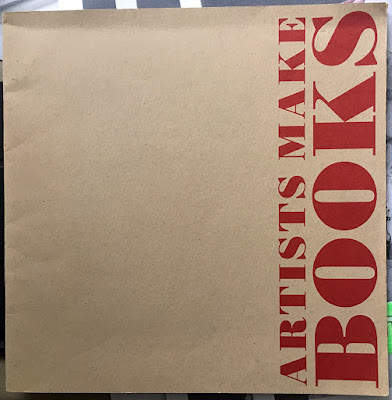
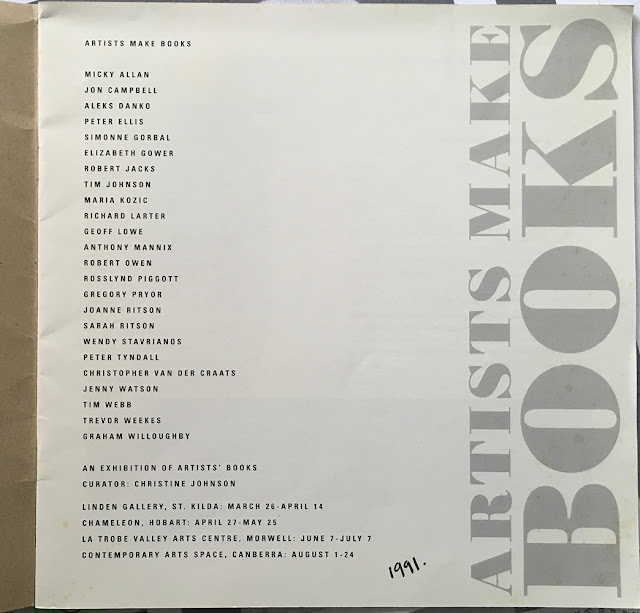

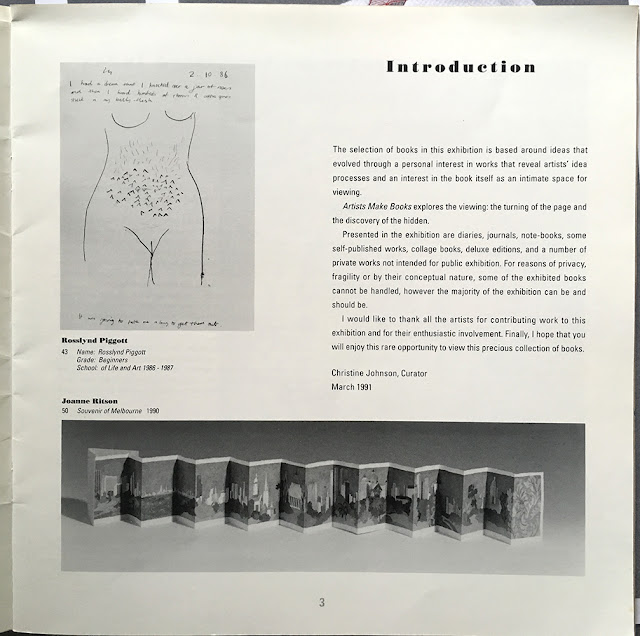
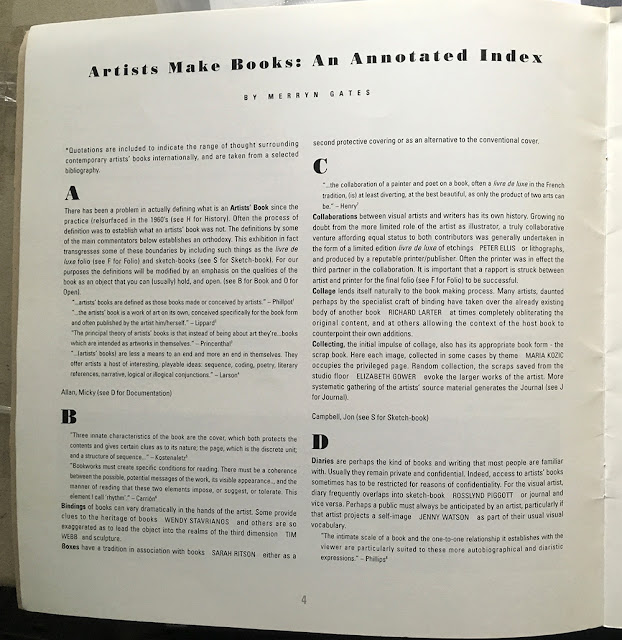

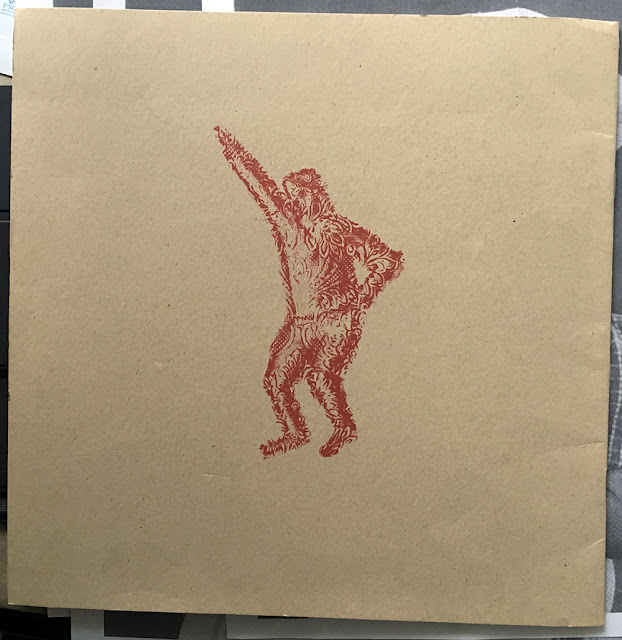
Woo Hoo and huge congratulations.
ReplyDeleteI 'think' it was you and a few like minded bloggers who introduced me to artist's books. An introduction I treasure.
I have a very few of them at home and they fill me with awe, with wonder and with delight.
That's the best way to be, I reckon. I have heaps of them and it's a bit of a chore keeping track and appreciating them all! x
DeleteLovely post, Caren. Nice thing to be doing again, isn't it. I will always be grateful for having been introduced to book arts through you.
ReplyDelete